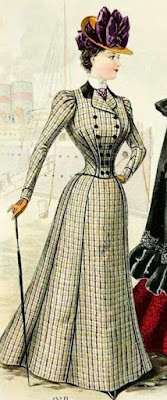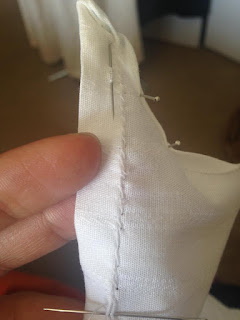How To Build A Character With Little To No Documentation
For the past couple of weeks I have been preparing a new historical character for an upcoming event with Historic Annapolis in preparation for Maryland Day Weekend. This past Sunday I portrayed Catherine Futier, a local laundress in Annapolis during the 1760's.
Of what information I could acquire, Catherine Futier was a free black woman and the only person in the black community documented to have a trade. While many trades peoples would advertise their services in the paper to gain new and occuring customers, Catherine chose not to advertise her services in the Maryland Gazette. Instead she got around by way of word of mouth - this not only benefited her by saving money (because printing would have been expensive during the time of the Stamp Act) but this was a good way of building a rapport with her customers. As a result, she did very well for herself and was able to rent a room and workspace at the Hogshead. Catherine also was also more than likely literate, as she needed to know how to read and write in order to conduct her business and keep tabs on what clothing items belonged to whom. Catherine was also documented to sue a white man for failure to pay for items she washed and mended for him. She supplied the money to hire a good lawyer and she won the case.
While this description of Catherine Futier sounds complete enough to tell her story, the thing is the story doesn't end here...or begin for that matter. There are still so many missing pieces to the whole puzzle! This paragraph is all I could muster up about her through assistance from Historic Annapolis and a few researcher friends of mine who knew how to pull information out of thin air; sadly there isn't any other historical documentation about Ms. Futier, other than a court case document and from a page in a book about Historic Annapolis. Wherein makes her more mysterious.....
I experienced the same dilemmas pertaining to my research while developing the character Maria Boston back in January. The only sole information I had to work with, was the court document provided.
So, that just leaves the big question of the day: How do you build a character from very little pieces of historic information?
I'm sure there are plenty of methods out there that other Reenactors and Interpreters use when preparing to portray a historic character that has little or no documentation, but I'll just talk about the basic method of what I use.
? WHO ?
? WHAT ?
? WHAT ?
? WHEN ?
? WHERE ?
? WHY ?
? HOW ?
? HOW ?
Believe it or not, I got this idea from my English & Literature classes back in grade school. In order to understand the fundamentals of the story and the main character of the books I read at the time, my teacher would use this method as a literary formula to break down the description. This is also used commonly when it comes to writing essays. I currently use this method when developing a new character and will pair that with any references or documentation I am given. So with that in mind, when you are starting your R&D, you'd want to ask deep and complex questions such as:
Who: is the individual you are portraying?
What: is that person's occupation, social status, etc. Is there a photo, a drawing or a painting of this person? If there isn't an image of the individual, would there be any description in the reference material?
For example, there are no photos or drawings of Maria Boston or Catherine Futier but because there is documentation that Catherine is a laundress and a free black woman, she would be wearing comfortable work clothes that were meant to get dirtied; Maria being a newly freed slave, would more than likely wear clothing she acquired from her former master's plantation and built new wardrobe pieces for herself.
When: what time period are they from? When were they born, when did they die? etc.
Where: where did they live, where were they born? When did they die, etc.
A good example would be to picture the individual you are researching (let's say, an English soldier during WWII who has very little information other than his draft card); where would that soldier be stationed? What would his MOS be (what occupation would he be assigned to), where did he reside before getting drafted and after the war, etc.
Why: This one is a little tricky, because the "why" question is not only self explanatory but can go into several different directions (ie. accidentally sending you down the rabbit hole).
Case in point, while you are developing your character you'd want to ask yourself questions like, why did he become a soldier, or how did she and her family feel having been forced to leave Richmond during the Civil War, or why would "___" be a British Loyalist and not a Patriot? These would be good questions to think about while you are doing research as well. Take notes if need be so you can refer to them later on.
How: how does that person make a living (what did they do on a daily basis?)
This method can also be applied when interacting with visitors.
Who - Who is your audience? (Students, Families, Adult individuals, etc.)
What - What do you want visitors to walk away with when knowing about the person you're portraying? What props would you be using to best interpret this character. What questions would you want your visitors to ask you, and what questions would you want to ask your visitors? I highly suggest using open-ended questions to get more out of your engagement with visitors; more than likely, this will lead into a conversation to loosen things up and make it more casual.
Where - Where is your stage (i.e. where are you meeting your audience?). If you are interpreting a soldier who is occupying Yorktown for example, then that's your character's setting; that's your stage where you'll perform.
When - When to engage, and when to back away.
I have plenty of examples where I have portrayed characters that some visitors are very interested in interacting with, and I have some visitors who...don't really feel comfortable talking to me (because of the obvious - I am a black woman portraying either a slave or freed). When you are dealing with reluctance, just understand that there will be pushback. There will be some visitors who will not interact with you, ask you questions or even answer them. It's not because they are being rude, but because most of the time they are shy and aren't used to being put on the spot and often times, do not know what to say. In dealing with tough topics such as slavery and then meeting an enslaved person, it's obvious that there will be discomfort. If they are not comfortable with the topic that you're teaching and there's pushback, then back away, BUT not all the way. Find another ice breaker to calm the waters.
Why - Again, this is a tricky part that can go into several directions. For instance, a visitor could be asking you a question that you feel is a pretty deep topic. "Why do you feel the need to interpret slavery when it's a shameful and dark part of our past?"
How - How do you want to engage with your visitors? This is kind of piggybacking off of the "what".
If you happen to know of any other methods or have suggestions, please feel free to add in the comments below. I feel that this is a learning experience for all, and everyone is certainly welcome to open information to better improve their impressions.





.jpg)


This is so interesting! Thanks so much :)
ReplyDelete